Algonquin College FAM 1003: Comparative Report on Learning Theories
VerifiedAdded on 2022/09/26
|8
|1634
|29
Report
AI Summary
This report provides a comparative analysis of three prominent learning theories: Behaviorism (Bandura), Erikson's psychosocial development, and Gardner's multiple intelligences. The paper begins with an introduction outlining the purpose of the comparison. It then offers an overview of each theory, highlighting key components and the rationale for their selection. The core of the report is a comparative chart that examines each theory's impact on physical environments, educator-child interactions, and professional practices, linking theoretical concepts to practical applications and observed examples. The report concludes by emphasizing the importance of integrating these theories into early learning programs to foster effective learning environments and support children's development. The student utilizes the assignment brief provided to structure their work and makes connections to the pedagogy framework.
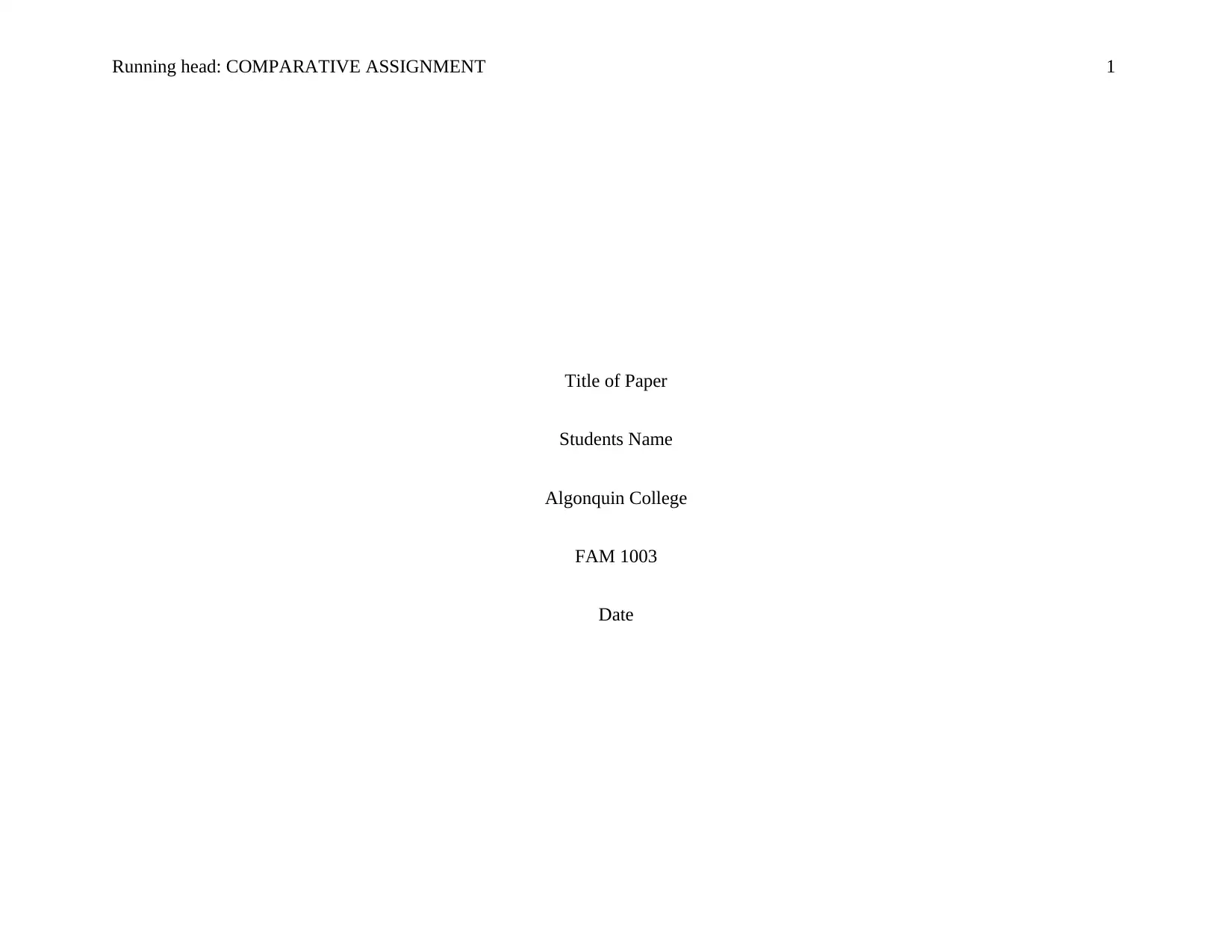
Running head: COMPARATIVE ASSIGNMENT 1
Title of Paper
Students Name
Algonquin College
FAM 1003
Date
Title of Paper
Students Name
Algonquin College
FAM 1003
Date
Paraphrase This Document
Need a fresh take? Get an instant paraphrase of this document with our AI Paraphraser
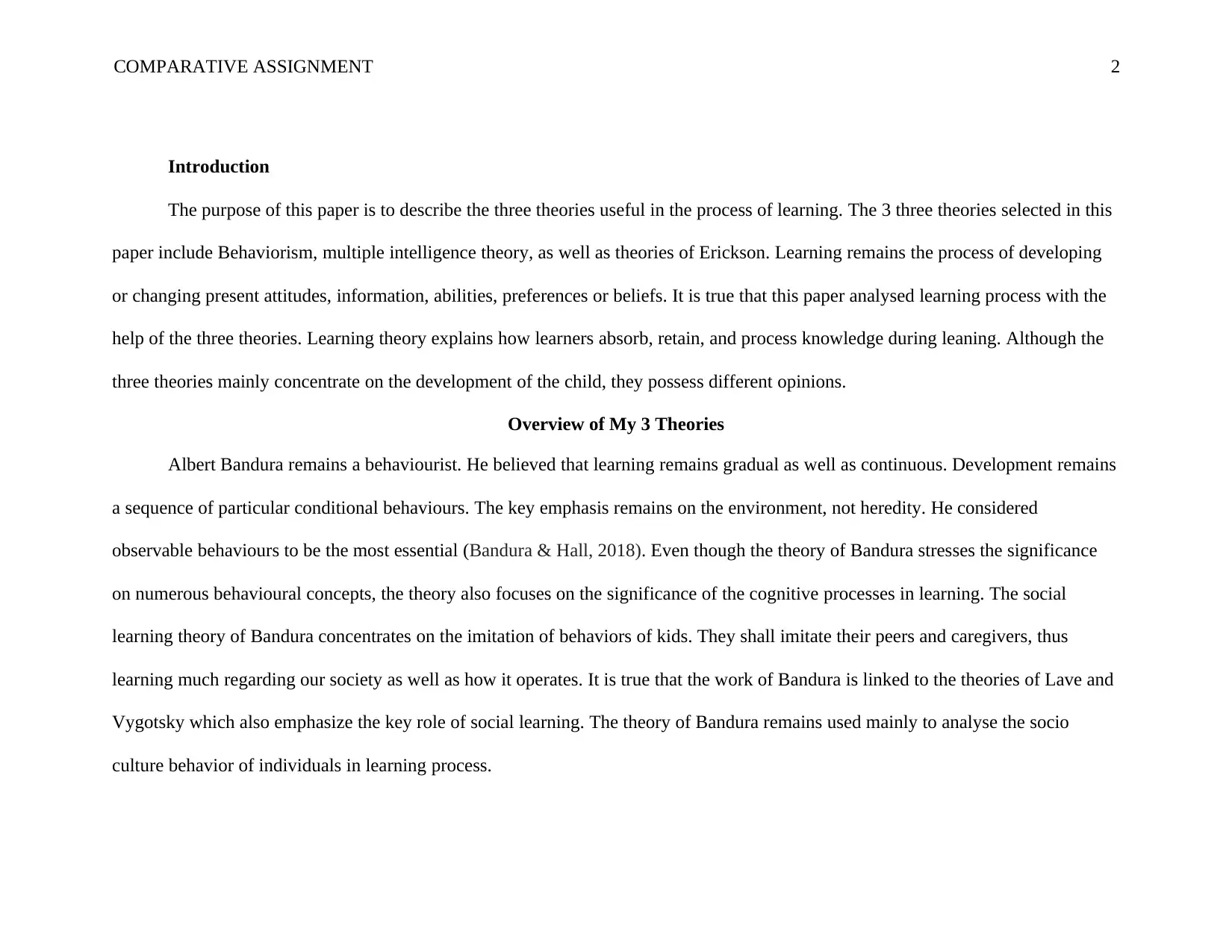
COMPARATIVE ASSIGNMENT 2
Introduction
The purpose of this paper is to describe the three theories useful in the process of learning. The 3 three theories selected in this
paper include Behaviorism, multiple intelligence theory, as well as theories of Erickson. Learning remains the process of developing
or changing present attitudes, information, abilities, preferences or beliefs. It is true that this paper analysed learning process with the
help of the three theories. Learning theory explains how learners absorb, retain, and process knowledge during leaning. Although the
three theories mainly concentrate on the development of the child, they possess different opinions.
Overview of My 3 Theories
Albert Bandura remains a behaviourist. He believed that learning remains gradual as well as continuous. Development remains
a sequence of particular conditional behaviours. The key emphasis remains on the environment, not heredity. He considered
observable behaviours to be the most essential (Bandura & Hall, 2018). Even though the theory of Bandura stresses the significance
on numerous behavioural concepts, the theory also focuses on the significance of the cognitive processes in learning. The social
learning theory of Bandura concentrates on the imitation of behaviors of kids. They shall imitate their peers and caregivers, thus
learning much regarding our society as well as how it operates. It is true that the work of Bandura is linked to the theories of Lave and
Vygotsky which also emphasize the key role of social learning. The theory of Bandura remains used mainly to analyse the socio
culture behavior of individuals in learning process.
Introduction
The purpose of this paper is to describe the three theories useful in the process of learning. The 3 three theories selected in this
paper include Behaviorism, multiple intelligence theory, as well as theories of Erickson. Learning remains the process of developing
or changing present attitudes, information, abilities, preferences or beliefs. It is true that this paper analysed learning process with the
help of the three theories. Learning theory explains how learners absorb, retain, and process knowledge during leaning. Although the
three theories mainly concentrate on the development of the child, they possess different opinions.
Overview of My 3 Theories
Albert Bandura remains a behaviourist. He believed that learning remains gradual as well as continuous. Development remains
a sequence of particular conditional behaviours. The key emphasis remains on the environment, not heredity. He considered
observable behaviours to be the most essential (Bandura & Hall, 2018). Even though the theory of Bandura stresses the significance
on numerous behavioural concepts, the theory also focuses on the significance of the cognitive processes in learning. The social
learning theory of Bandura concentrates on the imitation of behaviors of kids. They shall imitate their peers and caregivers, thus
learning much regarding our society as well as how it operates. It is true that the work of Bandura is linked to the theories of Lave and
Vygotsky which also emphasize the key role of social learning. The theory of Bandura remains used mainly to analyse the socio
culture behavior of individuals in learning process.
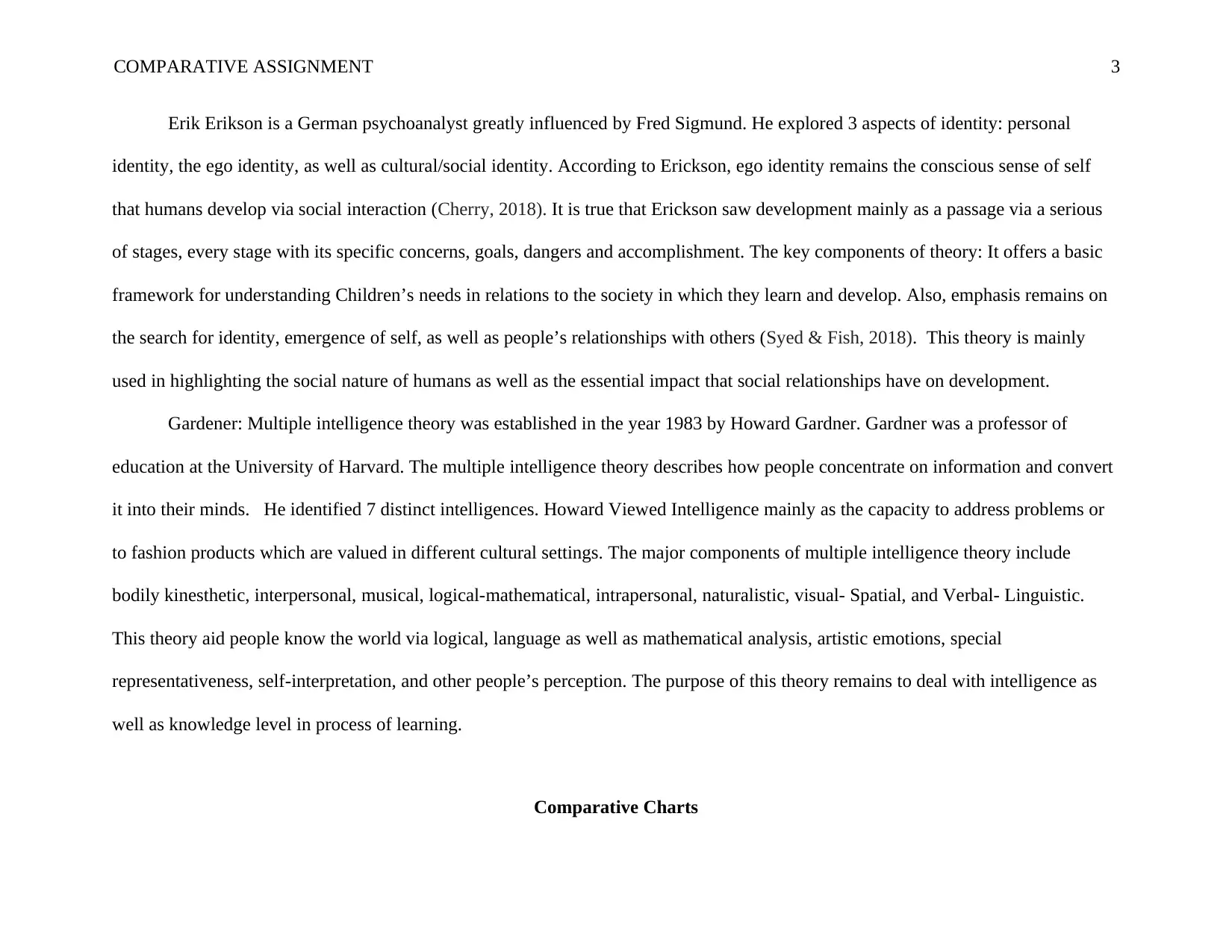
COMPARATIVE ASSIGNMENT 3
Erik Erikson is a German psychoanalyst greatly influenced by Fred Sigmund. He explored 3 aspects of identity: personal
identity, the ego identity, as well as cultural/social identity. According to Erickson, ego identity remains the conscious sense of self
that humans develop via social interaction (Cherry, 2018). It is true that Erickson saw development mainly as a passage via a serious
of stages, every stage with its specific concerns, goals, dangers and accomplishment. The key components of theory: It offers a basic
framework for understanding Children’s needs in relations to the society in which they learn and develop. Also, emphasis remains on
the search for identity, emergence of self, as well as people’s relationships with others (Syed & Fish, 2018). This theory is mainly
used in highlighting the social nature of humans as well as the essential impact that social relationships have on development.
Gardener: Multiple intelligence theory was established in the year 1983 by Howard Gardner. Gardner was a professor of
education at the University of Harvard. The multiple intelligence theory describes how people concentrate on information and convert
it into their minds. He identified 7 distinct intelligences. Howard Viewed Intelligence mainly as the capacity to address problems or
to fashion products which are valued in different cultural settings. The major components of multiple intelligence theory include
bodily kinesthetic, interpersonal, musical, logical-mathematical, intrapersonal, naturalistic, visual- Spatial, and Verbal- Linguistic.
This theory aid people know the world via logical, language as well as mathematical analysis, artistic emotions, special
representativeness, self-interpretation, and other people’s perception. The purpose of this theory remains to deal with intelligence as
well as knowledge level in process of learning.
Comparative Charts
Erik Erikson is a German psychoanalyst greatly influenced by Fred Sigmund. He explored 3 aspects of identity: personal
identity, the ego identity, as well as cultural/social identity. According to Erickson, ego identity remains the conscious sense of self
that humans develop via social interaction (Cherry, 2018). It is true that Erickson saw development mainly as a passage via a serious
of stages, every stage with its specific concerns, goals, dangers and accomplishment. The key components of theory: It offers a basic
framework for understanding Children’s needs in relations to the society in which they learn and develop. Also, emphasis remains on
the search for identity, emergence of self, as well as people’s relationships with others (Syed & Fish, 2018). This theory is mainly
used in highlighting the social nature of humans as well as the essential impact that social relationships have on development.
Gardener: Multiple intelligence theory was established in the year 1983 by Howard Gardner. Gardner was a professor of
education at the University of Harvard. The multiple intelligence theory describes how people concentrate on information and convert
it into their minds. He identified 7 distinct intelligences. Howard Viewed Intelligence mainly as the capacity to address problems or
to fashion products which are valued in different cultural settings. The major components of multiple intelligence theory include
bodily kinesthetic, interpersonal, musical, logical-mathematical, intrapersonal, naturalistic, visual- Spatial, and Verbal- Linguistic.
This theory aid people know the world via logical, language as well as mathematical analysis, artistic emotions, special
representativeness, self-interpretation, and other people’s perception. The purpose of this theory remains to deal with intelligence as
well as knowledge level in process of learning.
Comparative Charts
⊘ This is a preview!⊘
Do you want full access?
Subscribe today to unlock all pages.

Trusted by 1+ million students worldwide
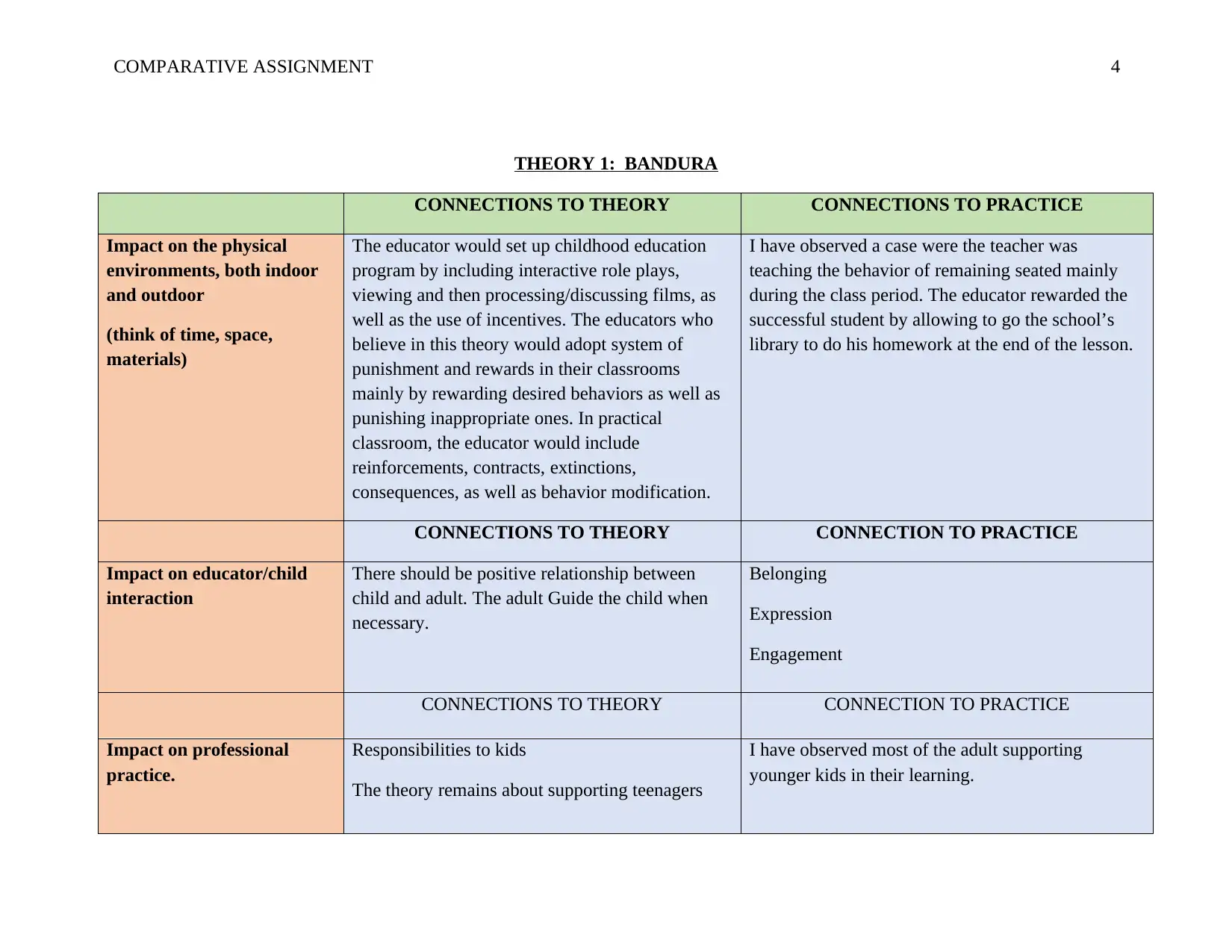
COMPARATIVE ASSIGNMENT 4
THEORY 1: BANDURA
CONNECTIONS TO THEORY CONNECTIONS TO PRACTICE
Impact on the physical
environments, both indoor
and outdoor
(think of time, space,
materials)
The educator would set up childhood education
program by including interactive role plays,
viewing and then processing/discussing films, as
well as the use of incentives. The educators who
believe in this theory would adopt system of
punishment and rewards in their classrooms
mainly by rewarding desired behaviors as well as
punishing inappropriate ones. In practical
classroom, the educator would include
reinforcements, contracts, extinctions,
consequences, as well as behavior modification.
I have observed a case were the teacher was
teaching the behavior of remaining seated mainly
during the class period. The educator rewarded the
successful student by allowing to go the school’s
library to do his homework at the end of the lesson.
CONNECTIONS TO THEORY CONNECTION TO PRACTICE
Impact on educator/child
interaction
There should be positive relationship between
child and adult. The adult Guide the child when
necessary.
Belonging
Expression
Engagement
CONNECTIONS TO THEORY CONNECTION TO PRACTICE
Impact on professional
practice.
Responsibilities to kids
The theory remains about supporting teenagers
I have observed most of the adult supporting
younger kids in their learning.
THEORY 1: BANDURA
CONNECTIONS TO THEORY CONNECTIONS TO PRACTICE
Impact on the physical
environments, both indoor
and outdoor
(think of time, space,
materials)
The educator would set up childhood education
program by including interactive role plays,
viewing and then processing/discussing films, as
well as the use of incentives. The educators who
believe in this theory would adopt system of
punishment and rewards in their classrooms
mainly by rewarding desired behaviors as well as
punishing inappropriate ones. In practical
classroom, the educator would include
reinforcements, contracts, extinctions,
consequences, as well as behavior modification.
I have observed a case were the teacher was
teaching the behavior of remaining seated mainly
during the class period. The educator rewarded the
successful student by allowing to go the school’s
library to do his homework at the end of the lesson.
CONNECTIONS TO THEORY CONNECTION TO PRACTICE
Impact on educator/child
interaction
There should be positive relationship between
child and adult. The adult Guide the child when
necessary.
Belonging
Expression
Engagement
CONNECTIONS TO THEORY CONNECTION TO PRACTICE
Impact on professional
practice.
Responsibilities to kids
The theory remains about supporting teenagers
I have observed most of the adult supporting
younger kids in their learning.
Paraphrase This Document
Need a fresh take? Get an instant paraphrase of this document with our AI Paraphraser
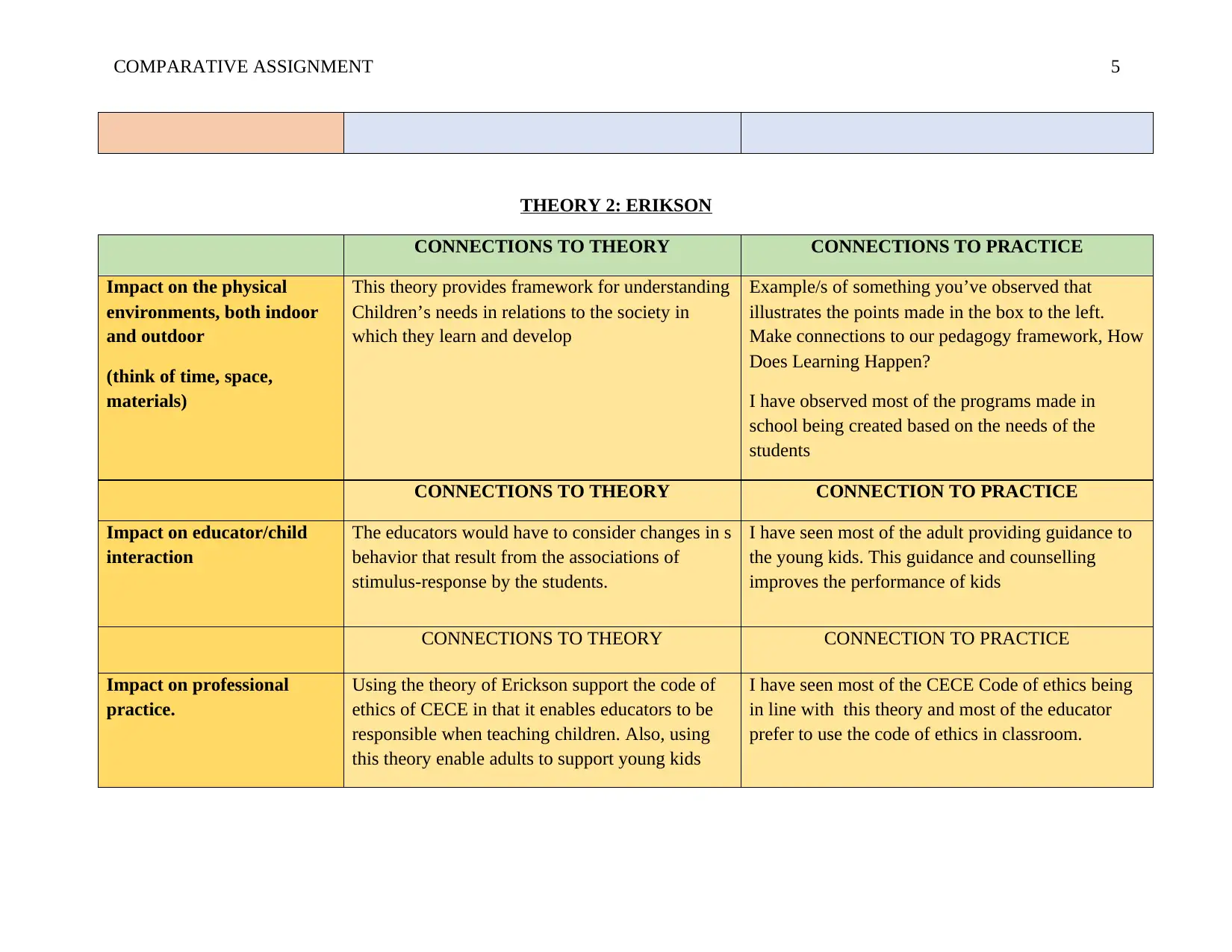
COMPARATIVE ASSIGNMENT 5
THEORY 2: ERIKSON
CONNECTIONS TO THEORY CONNECTIONS TO PRACTICE
Impact on the physical
environments, both indoor
and outdoor
(think of time, space,
materials)
This theory provides framework for understanding
Children’s needs in relations to the society in
which they learn and develop
Example/s of something you’ve observed that
illustrates the points made in the box to the left.
Make connections to our pedagogy framework, How
Does Learning Happen?
I have observed most of the programs made in
school being created based on the needs of the
students
CONNECTIONS TO THEORY CONNECTION TO PRACTICE
Impact on educator/child
interaction
The educators would have to consider changes in s
behavior that result from the associations of
stimulus-response by the students.
I have seen most of the adult providing guidance to
the young kids. This guidance and counselling
improves the performance of kids
CONNECTIONS TO THEORY CONNECTION TO PRACTICE
Impact on professional
practice.
Using the theory of Erickson support the code of
ethics of CECE in that it enables educators to be
responsible when teaching children. Also, using
this theory enable adults to support young kids
I have seen most of the CECE Code of ethics being
in line with this theory and most of the educator
prefer to use the code of ethics in classroom.
THEORY 2: ERIKSON
CONNECTIONS TO THEORY CONNECTIONS TO PRACTICE
Impact on the physical
environments, both indoor
and outdoor
(think of time, space,
materials)
This theory provides framework for understanding
Children’s needs in relations to the society in
which they learn and develop
Example/s of something you’ve observed that
illustrates the points made in the box to the left.
Make connections to our pedagogy framework, How
Does Learning Happen?
I have observed most of the programs made in
school being created based on the needs of the
students
CONNECTIONS TO THEORY CONNECTION TO PRACTICE
Impact on educator/child
interaction
The educators would have to consider changes in s
behavior that result from the associations of
stimulus-response by the students.
I have seen most of the adult providing guidance to
the young kids. This guidance and counselling
improves the performance of kids
CONNECTIONS TO THEORY CONNECTION TO PRACTICE
Impact on professional
practice.
Using the theory of Erickson support the code of
ethics of CECE in that it enables educators to be
responsible when teaching children. Also, using
this theory enable adults to support young kids
I have seen most of the CECE Code of ethics being
in line with this theory and most of the educator
prefer to use the code of ethics in classroom.
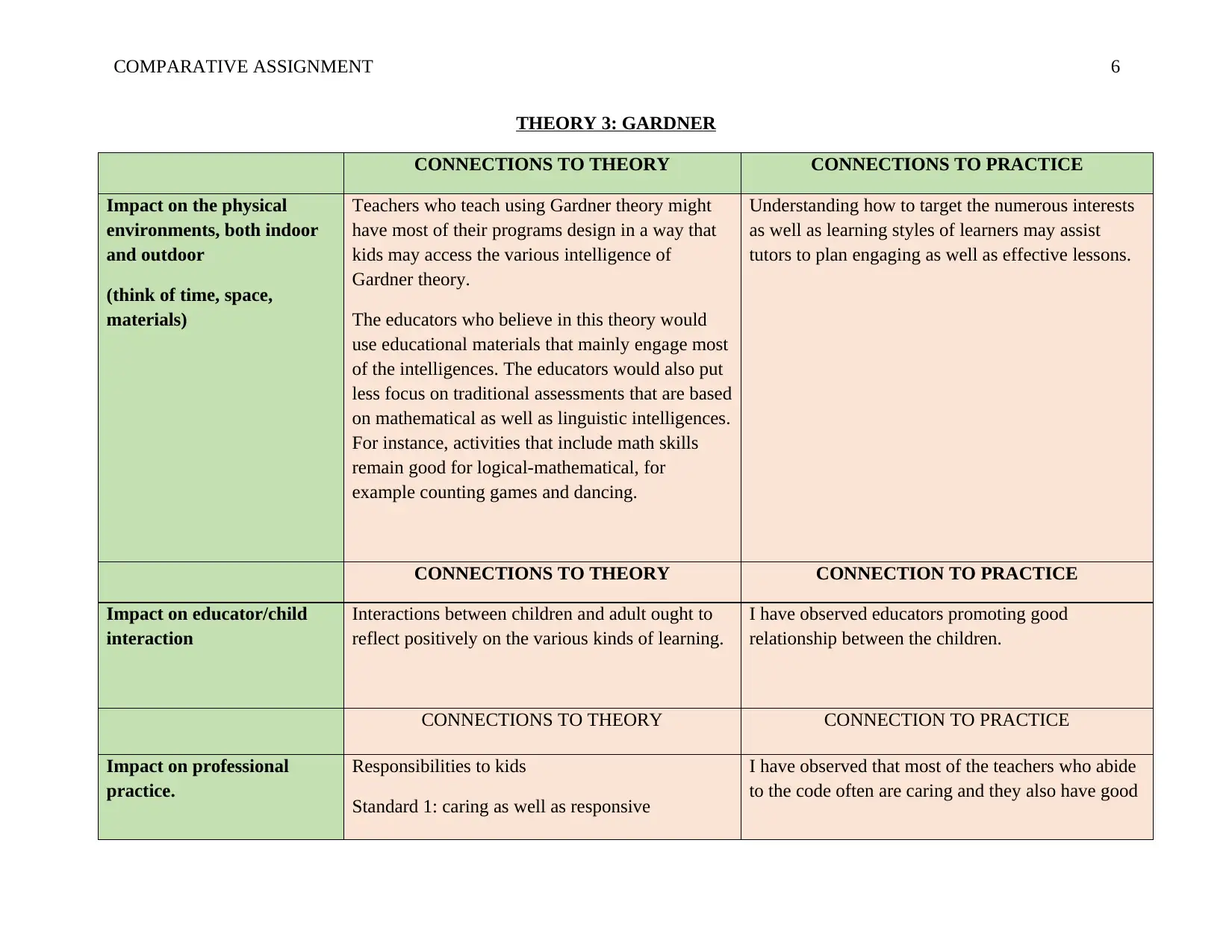
COMPARATIVE ASSIGNMENT 6
THEORY 3: GARDNER
CONNECTIONS TO THEORY CONNECTIONS TO PRACTICE
Impact on the physical
environments, both indoor
and outdoor
(think of time, space,
materials)
Teachers who teach using Gardner theory might
have most of their programs design in a way that
kids may access the various intelligence of
Gardner theory.
The educators who believe in this theory would
use educational materials that mainly engage most
of the intelligences. The educators would also put
less focus on traditional assessments that are based
on mathematical as well as linguistic intelligences.
For instance, activities that include math skills
remain good for logical-mathematical, for
example counting games and dancing.
Understanding how to target the numerous interests
as well as learning styles of learners may assist
tutors to plan engaging as well as effective lessons.
CONNECTIONS TO THEORY CONNECTION TO PRACTICE
Impact on educator/child
interaction
Interactions between children and adult ought to
reflect positively on the various kinds of learning.
I have observed educators promoting good
relationship between the children.
CONNECTIONS TO THEORY CONNECTION TO PRACTICE
Impact on professional
practice.
Responsibilities to kids
Standard 1: caring as well as responsive
I have observed that most of the teachers who abide
to the code often are caring and they also have good
THEORY 3: GARDNER
CONNECTIONS TO THEORY CONNECTIONS TO PRACTICE
Impact on the physical
environments, both indoor
and outdoor
(think of time, space,
materials)
Teachers who teach using Gardner theory might
have most of their programs design in a way that
kids may access the various intelligence of
Gardner theory.
The educators who believe in this theory would
use educational materials that mainly engage most
of the intelligences. The educators would also put
less focus on traditional assessments that are based
on mathematical as well as linguistic intelligences.
For instance, activities that include math skills
remain good for logical-mathematical, for
example counting games and dancing.
Understanding how to target the numerous interests
as well as learning styles of learners may assist
tutors to plan engaging as well as effective lessons.
CONNECTIONS TO THEORY CONNECTION TO PRACTICE
Impact on educator/child
interaction
Interactions between children and adult ought to
reflect positively on the various kinds of learning.
I have observed educators promoting good
relationship between the children.
CONNECTIONS TO THEORY CONNECTION TO PRACTICE
Impact on professional
practice.
Responsibilities to kids
Standard 1: caring as well as responsive
I have observed that most of the teachers who abide
to the code often are caring and they also have good
⊘ This is a preview!⊘
Do you want full access?
Subscribe today to unlock all pages.

Trusted by 1+ million students worldwide
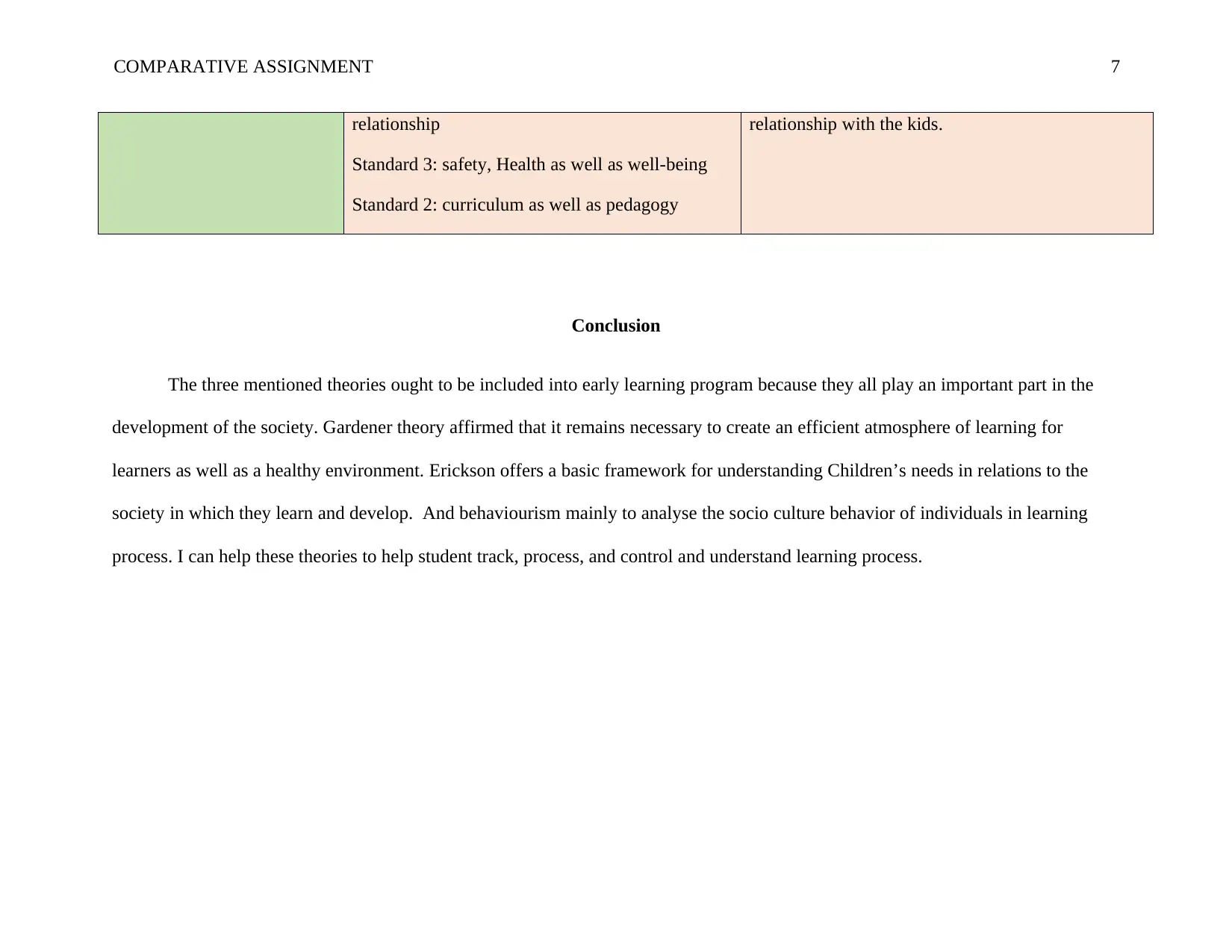
COMPARATIVE ASSIGNMENT 7
relationship
Standard 3: safety, Health as well as well-being
Standard 2: curriculum as well as pedagogy
relationship with the kids.
Conclusion
The three mentioned theories ought to be included into early learning program because they all play an important part in the
development of the society. Gardener theory affirmed that it remains necessary to create an efficient atmosphere of learning for
learners as well as a healthy environment. Erickson offers a basic framework for understanding Children’s needs in relations to the
society in which they learn and develop. And behaviourism mainly to analyse the socio culture behavior of individuals in learning
process. I can help these theories to help student track, process, and control and understand learning process.
relationship
Standard 3: safety, Health as well as well-being
Standard 2: curriculum as well as pedagogy
relationship with the kids.
Conclusion
The three mentioned theories ought to be included into early learning program because they all play an important part in the
development of the society. Gardener theory affirmed that it remains necessary to create an efficient atmosphere of learning for
learners as well as a healthy environment. Erickson offers a basic framework for understanding Children’s needs in relations to the
society in which they learn and develop. And behaviourism mainly to analyse the socio culture behavior of individuals in learning
process. I can help these theories to help student track, process, and control and understand learning process.
Paraphrase This Document
Need a fresh take? Get an instant paraphrase of this document with our AI Paraphraser
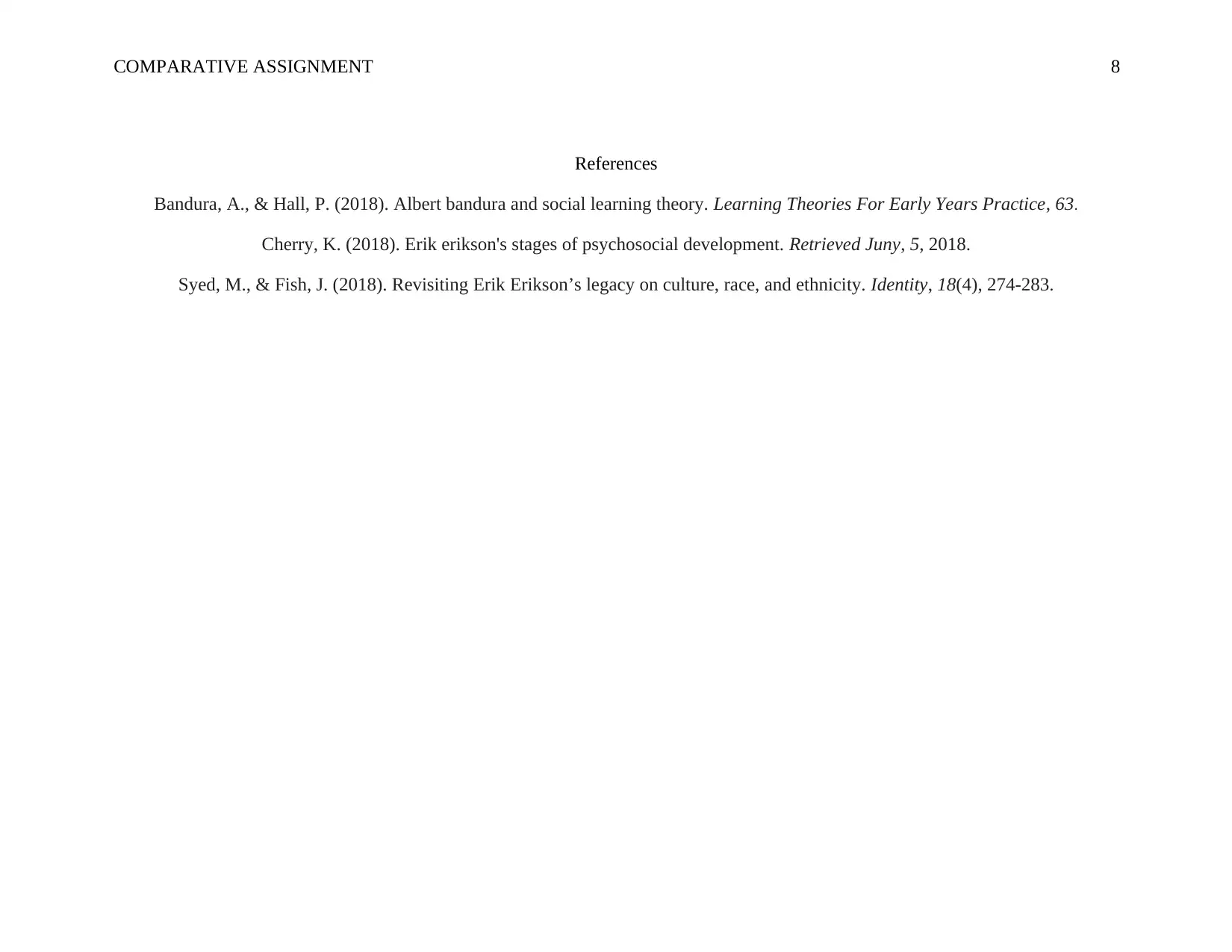
COMPARATIVE ASSIGNMENT 8
References
Bandura, A., & Hall, P. (2018). Albert bandura and social learning theory. Learning Theories For Early Years Practice, 63.
Cherry, K. (2018). Erik erikson's stages of psychosocial development. Retrieved Juny, 5, 2018.
Syed, M., & Fish, J. (2018). Revisiting Erik Erikson’s legacy on culture, race, and ethnicity. Identity, 18(4), 274-283.
References
Bandura, A., & Hall, P. (2018). Albert bandura and social learning theory. Learning Theories For Early Years Practice, 63.
Cherry, K. (2018). Erik erikson's stages of psychosocial development. Retrieved Juny, 5, 2018.
Syed, M., & Fish, J. (2018). Revisiting Erik Erikson’s legacy on culture, race, and ethnicity. Identity, 18(4), 274-283.
1 out of 8
Related Documents
Your All-in-One AI-Powered Toolkit for Academic Success.
+13062052269
info@desklib.com
Available 24*7 on WhatsApp / Email
![[object Object]](/_next/static/media/star-bottom.7253800d.svg)
Unlock your academic potential
Copyright © 2020–2025 A2Z Services. All Rights Reserved. Developed and managed by ZUCOL.




